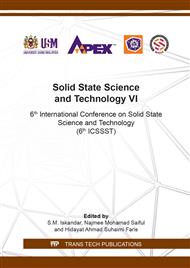p.252
p.261
p.267
p.274
p.280
p.286
p.292
p.301
p.307
Morphology Controlled Synthesis of ZnO Nanorods for Glucose Enzymatic Biosensor
Abstract:
The use of zinc oxide nanorods is a promising option to increase the specific area for efficient glucose oxidase immobilization which further enhance the signal performance of glucose detection. In this work ZnO nanorods were prepared via hydrothermal process on sol-gel ZnO seed layer. The effects of different temperature of annealed seed layer on the morphology and properties of grow ZnO nanorods were investigated. The ZnO seed layers were annealed at various temperatures ranging from 300 to 600 °C for 2 h. The study demonstrated that the process condition of ZnO seed layer had a strong influence on the morphology and crystallinity of ZnO nanorods grow. X-ray diffraction analysis and scanning electronic microscopy were employed to characterize the crystal structure and morphology of the prepared ZnO seed layer and grow ZnO nanorods. The performance of different aspect ratio of ZnO nanorods on glucose detection were measured by using electrochemical analysis. With optimized ZnO nanorods, the glucose biosensor exhibited an enhanced in signal performance with a high sensitivity of 11.36 μA mM-1 cm-2 in the range of 0.05-1 mM. Such high performance was due to more immobilization on the well-aligned ZnO nanorods array and direct electron conduction between the nanorods and the electrodes
Info:
Periodical:
Pages:
280-285
Citation:
Online since:
April 2019
Price:
Сopyright:
© 2019 Trans Tech Publications Ltd. All Rights Reserved
Share:
Citation:


